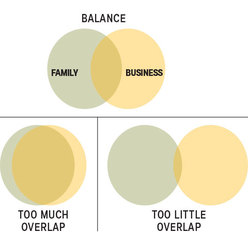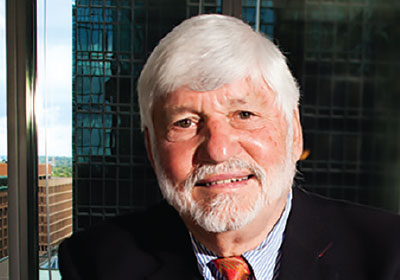Family dynamics can easily become disruptive when the balance is off between the family and business.

Family businesses are the most common form of enterprise in the world. Of course, that’s a wide net when you define both the rice farmer in Vietnam and the Wal-Mart clan as business families. The point is that business families comprise the majority of enterprises across the globe. Yet because they are privately owned, they can produce highly personal and emotional dilemmas. A mom can get caught in the middle.
This was the case with the Howard family (names have been changed). From the start, Mary Howard worked side-by-side with her husband. He worked outside and handled all of the production; Mary managed work inside and kept the books. Their business thrived. They had four children engaged in the business.
Two years ago Mary’s husband died unexpectedly at a young age. Mary inherited control of the entire company with a new role as chairman of the board. Her four children took on greater responsibilities. Her oldest, Tim, took charge of production. Kitty, a daughter, tackled accounting and books. The middle son, Dennis, became company president. And Joe, the youngest, worked with his oldest brother to help manage the production department. Although Mary was the board chair, she also was Mom, and she got caught between the business and her adult children over the issue of compensation.
Families that own and run businesses have the unique structure of being relatives as well as business colleagues. This produces an unavoidable overlap between the interests of the family and the interests of the business. It’s a critical balance the majority of business families fail to address.
To resolve the situation, Mary decided to pay Tim the most since he was the oldest child. She also reasoned that he should get the most because he had more children and needed extra money to raise them.
This decision only made Dennis and Tim upset with each other. President Dennis felt he was being treated unprofessionally. They were at a stalemate because family sensitivities were interfering with business formalities. My clients often tell me: “We don’t need all that structure and formality because we love each other.” I say, “It’s because you love each other that you need structure and formality.”
We determined that the Howards needed a compensation plan that included a family participation plan/code of conduct. This approach establishes the ground rules the family needs to run their family business.
In this case, I encouraged Mary and the family to adopt a compensation plan based on the four Ps of compensation: position, performance, percentile and premium. The four Ps model recognizes the position’s level of criticality, performance by the family member, what percentile the position should be paid, and whether the family member receives a premium due to family status.
We had Mary work with an accountant to establish the pay range for the positions her adult children held. Then we suggested she determine what she would pay each position in that range. Next we asked Mary to establish performance criteria for each of the positions so that each adult child knew what it took to do the job well and what bonus they would receive for that achievement. Last, we advised Mary to determine whether the adult children would receive a pay premium simply because they’re family members.
Mary followed our advice and formalized the compensation program. What started as Mom-in-the-middle torn between practical business needs and emotional family dynamics culminated in her transformation into a positive balance for family and business.
Mary implemented the necessary structure and formality for the business while preserving her family’s relationships. I’m happy to report that Dennis reconciled with his mom/chairman of the board, and Dennis and Tim recognized the value of each other as business partners and brothers. Business and family are thriving.
See original article on Twin Cities Business.
This was the case with the Howard family (names have been changed). From the start, Mary Howard worked side-by-side with her husband. He worked outside and handled all of the production; Mary managed work inside and kept the books. Their business thrived. They had four children engaged in the business.
Two years ago Mary’s husband died unexpectedly at a young age. Mary inherited control of the entire company with a new role as chairman of the board. Her four children took on greater responsibilities. Her oldest, Tim, took charge of production. Kitty, a daughter, tackled accounting and books. The middle son, Dennis, became company president. And Joe, the youngest, worked with his oldest brother to help manage the production department. Although Mary was the board chair, she also was Mom, and she got caught between the business and her adult children over the issue of compensation.
Families that own and run businesses have the unique structure of being relatives as well as business colleagues. This produces an unavoidable overlap between the interests of the family and the interests of the business. It’s a critical balance the majority of business families fail to address.
- When family and business are in balance, the overlap recognizes the worth and separation so that both the family and business systems thrive. The business is a success because the family’s values and culture are a source of enormous strength. They are the “secret sauce” in most family businesses, whether that’s the Vietnamese rice farmer or Sam Walton’s family.
- When family and business overlap too little, ordinary rules or expectations of business may be ignored or set aside. Family preferences (ever heard of nepotism?) creep into business decisions and undermine best practices. Examples of this problem often appear as excess compensation or a failure to conduct performance appraisals to hold family members accountable for their actions.
- When family and business overlap too much, the normal frictions of business and financial differences seep into and erode family relationships. Family gatherings and holidays are taken over by business discussions. Family members who feel they’re not being treated equally stop talking to each other. In-laws who object that business supersedes family are dismissed.
To resolve the situation, Mary decided to pay Tim the most since he was the oldest child. She also reasoned that he should get the most because he had more children and needed extra money to raise them.
This decision only made Dennis and Tim upset with each other. President Dennis felt he was being treated unprofessionally. They were at a stalemate because family sensitivities were interfering with business formalities. My clients often tell me: “We don’t need all that structure and formality because we love each other.” I say, “It’s because you love each other that you need structure and formality.”
We determined that the Howards needed a compensation plan that included a family participation plan/code of conduct. This approach establishes the ground rules the family needs to run their family business.
In this case, I encouraged Mary and the family to adopt a compensation plan based on the four Ps of compensation: position, performance, percentile and premium. The four Ps model recognizes the position’s level of criticality, performance by the family member, what percentile the position should be paid, and whether the family member receives a premium due to family status.
We had Mary work with an accountant to establish the pay range for the positions her adult children held. Then we suggested she determine what she would pay each position in that range. Next we asked Mary to establish performance criteria for each of the positions so that each adult child knew what it took to do the job well and what bonus they would receive for that achievement. Last, we advised Mary to determine whether the adult children would receive a pay premium simply because they’re family members.
Mary followed our advice and formalized the compensation program. What started as Mom-in-the-middle torn between practical business needs and emotional family dynamics culminated in her transformation into a positive balance for family and business.
Mary implemented the necessary structure and formality for the business while preserving her family’s relationships. I’m happy to report that Dennis reconciled with his mom/chairman of the board, and Dennis and Tim recognized the value of each other as business partners and brothers. Business and family are thriving.
See original article on Twin Cities Business.


 RSS Feed
RSS Feed
